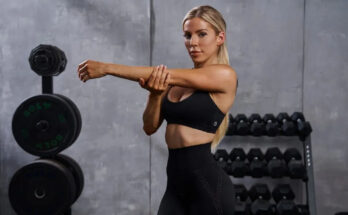Many lifters, beginners or otherwise, hit the gym with no plan that’s why we’ve created this New Year Workout Program—to help create a foolproof plan to get you started.
Besides losing a bit of the holiday flab and seeing muscles they haven’t seen in a while, some will begin their workout journey by aimlessly wandering around and imitating other people’s workouts or sometimes randomly being performing some unique exercises they’ve seen on Instagram.
Some realize it is more challenging than the video they watched—the precursor to many workout fail videos you’ll find on YouTube. So, please read this to avoid being one of them, and instead build the body you want and deserve with the 2023 New Year Workout Program. Here’s the thing many beginner lifters (and some experienced lifters) miss when it comes to getting stronger, building muscle, or losing fat.
Focus on the Basics in this 2023 New Year Workout Program
The basics have worked since Milo picked up a bull every day to get stronger. But the basics don’t sell, consistency doesn’t sell, and progressive overload doesn’t sell well—complicated training and nutrition plans with all the bells and whistles do.
Starting with the basics is where it is at before you get to the complicated training plans. Don’t believe me? Dr. Allan Bacon, Ph.D., an experienced online physique and nutrition coach, thinks you should keep the basics as the main routine.
“The main things to focus on for a beginner are mastering the basics, building a foundation of strength, and establishing a consistent training routine that will allow long-term progress.”
Progress is always the name of the gym game, and the lack of it is why people, particularly beginners, quit. Here we’ll dive into creating a complete workout program to keep you
progressing and balancing your strength and cardio when you haven’t the cash to hire a personal trainer. Let’s dive in.
What are the Basics For the 2023 New Year Workout Program
Well, one was described above, carrying heavy stuff — aka carries. Carries and other movements that are part of your daily activities are fundamental human movements.
What is meant by fundamental human movement? These daily movements are practiced since birth and should play a starring role in your routine. And they are:
- Sitting down and getting up—also known as squats.
- Bending over to pick something up—aka hinging
- Shutting a heavy door behind you—aka pulling
- Closing the fridge door in front of you—aka pushing
- Walking, running, lunging, carrying groceries, or climbing stairs: carries and locomotion.
These classifications differ from coach to coach, but it all means the same thing to you. Here are some resistance training examples of fundamental human movements.
- Squats: Bodyweight, goblet squats, split squats, Barbell squats
- Hinges: Bodyweight hip extensions, RDLs, deadlift variations, and hip thrusts
- Pushing: Pushups, dumbbell and barbell bench presses, shoulder presses, and cable presses
- Pulling: Chinups, pullups, seated rows, and dumbbell rows
- Locomotion: Carry variations, stepups, lunges, running (and walking) According to Bacon, many variations within the realm of human movements do similar things, which is excellent for you because it gives you choices.
“There are many ways to reach physique and performance goals, which means there is much variation in how an effective program can look. This is a positive because it means you can find what works for you and what you enjoy. You don’t have to train in a way you find unenjoyable or boring.”
That’s important because the second most significant reason for discontinuing exercise is that you find it boring and not fun. Don’t like barbell squats because they hurt your knees? Substitute goblet squats in, and you are good to go.
How To Approach Sets, Reps, and Other Stuff
Bacon says three to four sets of 8-12 reps should constitute the base of most beginner strength and lean muscle routines. Its moderate volume and weight allow people to challenge themselves without overdoing volume or causing them to handle weights they aren’t ready for. Plus, keeping the program to 4-6 exercises per training session is a reliable method to prevent excessive DOMS or overuse injuries.
Many beginners need help with consistency, but Bacon has a simple mindset switch to help.
“Habit building takes time, and people often have to force themselves to do it until it becomes second nature,” he says. “It is critical to view it as something you choose to do or get to do. Being healthy is a privilege, not an obligation. This mindset shift can make all the difference.”
It’s OK to miss one workout, but try not to miss it twice. Two skipped workouts could be the sad start of sending you back on the slippery slope to failure.
What To Do About Cardio
Cardiovascular exercise’s health and performance benefits are widely known, and there is no need to rehash them. Cardio is important; consider it the cherry on top of your strength training routine. With lots of choices for cardio, consider these three factors before choosing your mode of choice.
- Cardio mode is unimportant: There’s always speculation about which cardio mode is better. Is the rowing machine better than the bike? Is the treadmill better than the elliptical? But from a health standpoint, the cardio mode is not important because they all have the same heart health benefits. Choose the one you’ll do regularly, not one that burns the most calories.
- Make it fun: Michelle Segar, the author of “No Sweat,” believes enjoyment is the best motivator for exercise. “Logic doesn’t motivate us; emotions do,” says Segar. People who exercise for enjoyment stick with it more than those who do it for medical reasons. But I hate cardio; I hear you cry out. Guess what, me too, but we all know it’s good for us, like bad-tasting medicine. So, if you don’t find cardio fun, see what you hate the least.
- Intensity doesn’t matter: The two main types of cardio are high-intensity and steady-state, and both are broken up into subcategories, but for brevity’s sake, let’s stick to those. The main differences between HIIT and SST are time and duration. One is short, sweet, and intense; the other is longer and less intense. It’s often thought that HIIT is better for fat loss, but it isn’t because both are good for fat loss. So, choosing which method is a matter of how much time you have and your preference.
Putting it All Together For the 2023 New Year Workout Program
Here is a three 3-day-a-week 2023 New Year Workout Program that was built around human movements and the Big three of the squat, deadlift, and bench press. You’ll start at the lower end of the rep range, 8, and work up to 12 reps with the same weight. When you can lift 12 reps for all your sets, go up by 5 to 10 pounds and start the process again.
The program is 3 supersets, and you’ll complete each superset 3 to 4 times, resting a little between exercises and 1-2 minutes between supersets. You’ll have the option of performing one HIIT routine per week at the end of one of your strength training workouts or performing your cardio on a different day. Try to get at least two cardio sessions per week.
Day 1
- 1A. Squat variation (barbell, dumbbell, or hack)
- 1B. Hip flexor mobilization (6-8 reps per side)
- 2A. Pushup variation (8-25 reps)
- 2B. Chinup or lat pulldown
- 3A. Dumbbell unilateral row
- 3B. Unilateral overhead triceps extension
Day 2
- 1A. Bench press variation (barbell or dumbbell)
- 1B. Band pull-apart (15-20 reps)
- 2A. Hip thrust or weighted hip extension
- 2B. Suitcase Carry (40 yards on each side)
- 3A. Bilateral seated row
- 3B. Hamstring curl
Day 3
- 1A. Deadlift variation (barbell, dumbbell, or trap bar deadlift)
- 1B. Half-kneeling Pallof press (8-12 reps on each side)
- 2A. Unilateral landmine press
- 2B. TRX inverted row
- 3A.Split squat variations (bodyweight, TRX, or dumbbell)
- 3B. Dumbbell reverse flye
Cardiovascular Workout Examples
Try to get 8,000 to 10,000 steps per day regardless of whether you strength train or perform cardio that day. If you have trouble getting to 8,000 steps, then work on doing more than you currently do.
- HIIT example: Using any cardio machine, warm up for three to five minutes and then go as hard as you can for 30 seconds. Go slowly for 90 seconds and repeat the sequence 4 to 6 times. Cool for 5 minutes.
- Steady state example: 10/10/10 minutes. Spend 10 minutes on the bike, then 10 minutes on the treadmill, keeping the speed around 3 to 3.5 mph. Follow this with 10 minutes on the rowing machine. Any cardio machine will do; choose three different modes.
Source link
Originally posted 2023-01-02 19:28:23.




